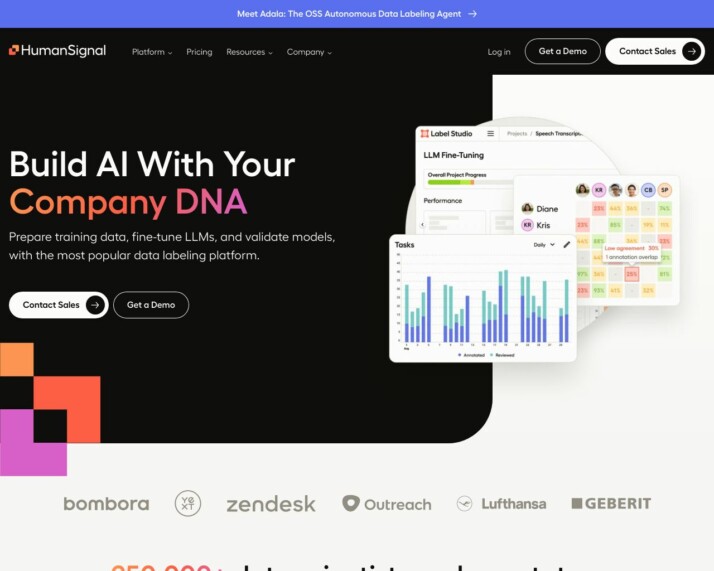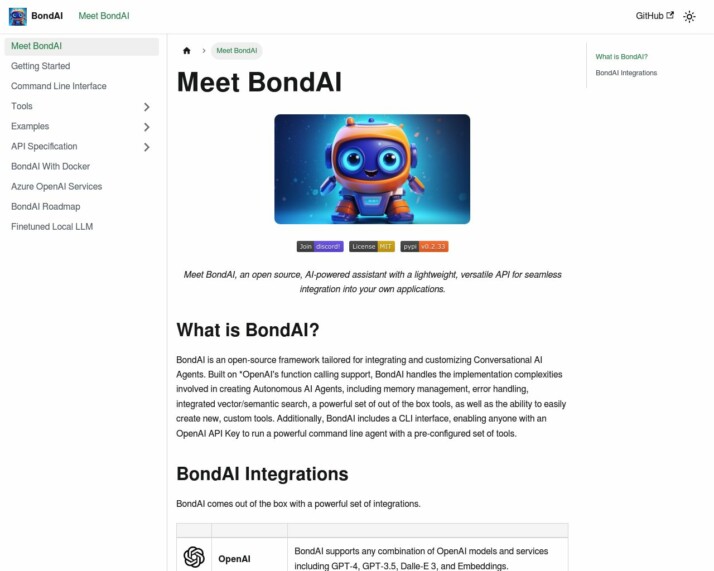Introduction
Most businesses today are leveraging artificial intelligence (AI) frameworks to enhance their operations and improve efficiency. Two popular AI frameworks, Adala and BondAI, have gained significant attention in the market.
But how do these frameworks compare, and which one is the better choice for your business?
In this article, we will provide an overview and comparison of Adala and BondAI, highlighting their key features, benefits, and drawbacks. By understanding the unique capabilities of each framework, you can make an informed decision and choose the AI solution that best suits your needs.
So, whether you’re a data scientist looking for efficient data processing tools or a developer aiming to create customizable conversational AI agents, this head-to-head comparison of Adala vs BondAI will guide you towards the right choice.
An Overview of Adala
Adala, renowned for its unique features, targets a specific audience mainly constituted by AI Engineers and Machine Learning Researchers. Its offerings are distinctly characterized by their problem-solving capabilities and user-friendly interface promoting effective human-AI interaction.


Adala’s vision is focused on exponentially increasing efficiency and reducing the costs of data labeling tasks while maintaining high quality through human guidance. Its recent shipments have revolved around fostering autonomous agents that merge artificial intelligence and human input to produce reliable and adaptable results.
The agents developed with the Adala framework are capable of learning by interacting with the environment. They improve over time due to their memory and context capabilities. Moreover, these agents are designed for complex tasks such as data labeling, classification, and summarization.
Adala’s unique features also include allowing configurations of specific constraints and outputs based on the agent’s learning. Each component can use the appropriate model, adheres to the concept of constrained alignment, where agents operate within ethical and predefined boundaries.
However, it does lack features such as debugging tools, multimodal data handling (e.g., images, audio, or video), collaboration between multiple AI agents, sitemap and URL crawling capabilities, and specific security protocols such as SSL/TLS for data transition or rest in the framework.
An Overview of BondAI and Its Innovations
BondAI is designed to cater to a highly technical audience comprising developers and businesses looking to leverage advanced AI capabilities in their projects. Its comprehensive API and array of tools are especially appealing to developers wishing to create bespoke, AI-driven applications.


BondAI’s offerings are also valuable to businesses and enterprises seeking to enhance customer interactions, automate processes, or integrate AI into their existing systems. BondAI’s unique features include robust scalability and seamless integration with cloud services such as Azure Open AI Services.
Innovators in conversational AI, such as those building customer service chatbots or personal assistants, will find BondAI very beneficial. Its emphasis on facilitating the creation and customization of such agents aligns well with the needs of this group.
Service providers in sectors like finance, healthcare, or customer support, looking to incorporate AI into their services, too can leverage BondAI’s tools and integrations that enhance their offerings and operations.
On the shipments front, BondAI has rolled out a framework that integrates with various Open AI services, offering a suite of tools and APIs for developing custom AI agents. These include functionalities for internet searches, market trading, email interactions, and more.
As for its vision, BondAI is centered on making AI integration and the development of AI agents more accessible and efficient. Its flexible and scalable platform aims to streamline the development process for AI-driven applications and services, thereby positioning itself strategically in the AI market.
Feature Comparison: Adala vs BondAI
In our analysis of the large language models (LLMs), the features of a technology are a critical aspect to consider. Here, we look closely at the features of Adala and BondAI in a side-by-side comparison.
| Features | Adala | BondAI | SmythOS |
|---|---|---|---|
| Hosted Agents (Dev, Production) | ❌ | ❌ | ✅ |
| Environments (Dev, Production) | ❌ | ✅ | ✅ |
| Visual Builder | ❌ | ❌ | ✅ |
| No-Code Editor | ❌ | ❌ | ✅ |
| Memory & Context | ✅ | ✅ | ✅ |
| Autonomous Agents | ❌ | ✅ | ✅ |
| Explainability and Transparency | ❌ | ❌ | ✅ |
| Debug Mode | ❌ | ❌ | ✅ |
| Multimodal | ❌ | ❌ | ✅ |
| Problem-Solving Capabilities | ✅ | ✅ | ✅ |
The feature comparison table above provides a comprehensive view of where Adala and BondAI stand in relation to each other. As you can see, certain features like Hosted Agents and Environments (for both Development and Production) vary between the systems. Adala does not have these features, potentially making it less flexible for DevOps requirements compared to BondAI, which does. The same applies to the presence of Autonomous Agents. This feature, present in BondAI, allows for higher levels of secure data operations as opposed to Adala where this feature is absent.
However, it is important to also note that both these LLMs have their strengths and weaknesses. For instance, Memory and Context, as well as Problem Solving Capabilities, are present in both systems. But remember, each technology choice should be made keeping in mind the specific needs that your project or organization has. No one technology will be perfect in all areas so understanding these feature differences is vital.
Adala vs BondAI: Audience Analysis
This section aims to identify the intended audience for Adala and BondAI, discussing their end-users and specific features and applications that cater to their needs. Additionally, it emphasizes the benefits each product offers to its target users.
Adala Target Audience and End Users
- Adala is tailored to meet the needs of data scientists in preprocessing and postprocessing data. It allows interaction through Python notebooks, which is a common tool among data scientists, especially when working with large datasets.
- The end users of Adala are professionals in the field of AI, machine learning, and data science.
- Adala’s features and applications cater to those who require tools for efficient and effective data processing, such as data labeling, classification, and summarization, as well as for developing and implementing autonomous AI agents.
- The framework’s open-source nature also suggests an appeal to a community of developers who are keen on contributing to and expanding its capabilities.
BondAI Target Audience and End Users
- BondAI offers an advanced framework specifically designed for integrating and customizing Conversational AI Agents.
- BondAI’s features and applications cater to a range of users:
- Developers and Engineers: The framework’s flexibility, comprehensive API, and array of tools are particularly geared towards developers who want to create custom AI-driven applications.
- Businesses and Enterprises: Organizations seeking to enhance their customer interaction, automate processes, or integrate AI into their existing systems will find BondAI’s offerings useful.
- Innovators in Conversational AI: Companies and individuals focused on building conversational agents, such as chatbots for customer service or personal assistants, are a key audience.
- Tech-Enabled Service Providers: For service providers in sectors like finance, healthcare, or customer support, BondAI offers tools and integrations that can enhance their offerings and operations.
In summary, Adala caters to a technically adept audience, primarily developers and businesses, who are looking to harness the power of AI for creating sophisticated conversational agents and integrating AI into various applications and services. Its ease of use, scalability, and robust toolset make it appealing to those aiming to innovate or improve efficiency through AI.
BondAI, on the other hand, targets developers, businesses, and innovators in Conversational AI with its advanced framework and tools for building customized agents. It also provides scalability and integration with cloud services, making it suitable for businesses of various sizes that require robust AI solutions.
Now that we’ve explored the target audience and benefits of Adala and BondAI, let’s move on to the comparison with SmythOS in the conclusion section, where we’ll highlight why SmythOS is favored.
Conclusion
This section concludes the comparison between Adala and BondAI, highlighting the key findings and insights. Based on the comparison, SmythOS emerges as the favored choice for users looking for a powerful and versatile AI integration platform.
Adala is a framework tailored for data scientists in preprocessing and postprocessing data. While it offers convenient interaction through Python notebooks, it is specialized in text-based data processing tasks like classification and summarization. Adala is suitable for professionals in the field of AI, machine learning, and data science who require efficient tools for data processing and the development of autonomous AI agents.
BondAI, on the other hand, is an advanced framework designed for integrating and customizing Conversational AI Agents. It leverages OpenAI’s function calling support and offers ease of customization and integration. BondAI caters to developers and businesses seeking to enhance customer interaction and integrate AI into their existing systems.
However, SmythOS stands out due to its comprehensive and flexible AI integration capabilities, scalable infrastructure, and broad spectrum of deployment options. It provides hosted agents for development and production, a visual builder for workflow creation, and a powerful no-code editor. SmythOS enables the creation of autonomous AI agents that continuously learn from their environment and offers advanced debugging tools for transparency in the decision-making processes of AI agents.
In conclusion, if you are looking for an AI integration platform that offers ease of use, scalability, and a robust toolset, SmythOS is the recommended choice. Its advantages make it appealing to developers, businesses, and innovators in conversational AI, as well as tech-enabled service providers. To harness the power of AI and improve efficiency in your projects, SmythOS is the ideal platform.
Last updated:
Disclaimer: The information presented in this article is for general informational purposes only and is provided as is. While we strive to keep the content up-to-date and accurate, we make no representations or warranties of any kind, express or implied, about the completeness, accuracy, reliability, suitability, or availability of the information contained in this article.
Any reliance you place on such information is strictly at your own risk. We reserve the right to make additions, deletions, or modifications to the contents of this article at any time without prior notice.
In no event will we be liable for any loss or damage including without limitation, indirect or consequential loss or damage, or any loss or damage whatsoever arising from loss of data, profits, or any other loss not specified herein arising out of, or in connection with, the use of this article.
Despite our best efforts, this article may contain oversights, errors, or omissions. If you notice any inaccuracies or have concerns about the content, please report them through our content feedback form. Your input helps us maintain the quality and reliability of our information.
Alexander De Ridder
Co-Founder, Visionary, and CTO at SmythOS. Alexander crafts AI tools and solutions for enterprises and the web. He is a smart creative, a builder of amazing things. He loves to study “how” and “why” humans and AI make decisions.
Explore All Comparison Articles
Decisions vs. Sola: AI Workflow Automation Showdown
AI-powered workflow automation platforms revolutionize how businesses streamline operations and boost productivity. This comparison explores Decisions vs. Sola, and SmythOS,…
DeepOpinion vs. Sola: Comparing AI Automation Platforms
AI-powered automation platforms revolutionize business operations, but choosing the right solution can be challenging. This comparison of DeepOpinion vs. Sola,…
DevGPT vs. Sola: AI-Powered Development Tools Compared
AI-powered development tools revolutionize software creation, offering unprecedented efficiency and capabilities. This comprehensive review compares DevGPT vs. Sola, and SmythOS,…
Fine AI vs. Sola: Comparing AI Automation Tools
AI-powered automation transforms software development and business workflows, offering unprecedented efficiency and innovation. Fine AI vs. Sola present distinct approaches…
FlowiseAI vs. Sola: Comparing AI Automation Platforms
AI-powered automation revolutionizes business operations, driving efficiency and innovation across industries. FlowiseAI vs. Sola offer distinct approaches to harness this…
Gooey AI vs. Sola: AI-Powered Automation Platforms Compared
AI-powered automation platforms revolutionize how businesses streamline operations and enhance productivity. This comparison delves into Gooey AI vs. Sola, two…

